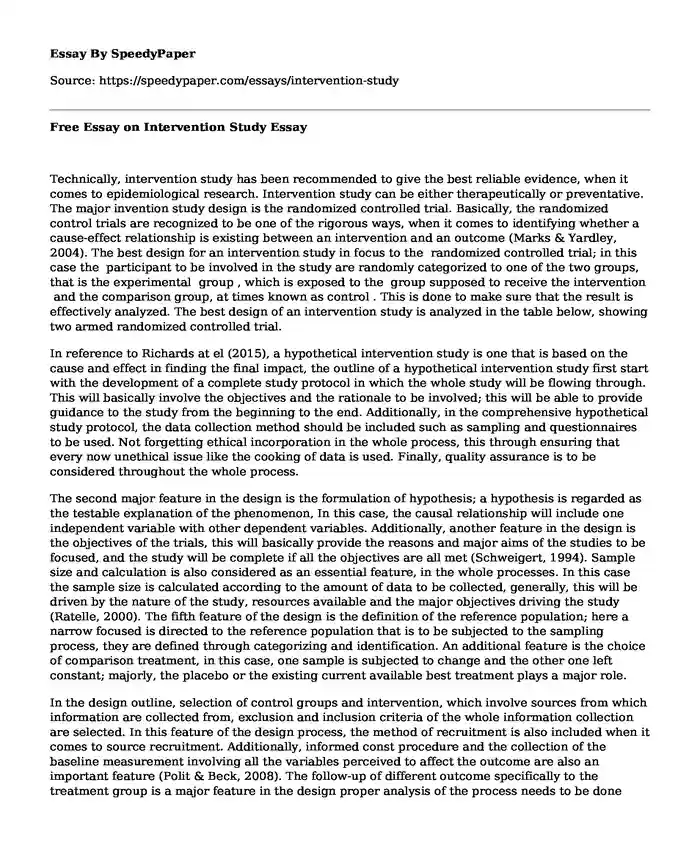
| Type of paper: | Essay |
| Categories: | Psychology Research |
| Pages: | 3 |
| Wordcount: | 741 words |
Technically, intervention study has been recommended to give the best reliable evidence, when it comes to epidemiological research. Intervention study can be either therapeutically or preventative. The major invention study design is the randomized controlled trial. Basically, the randomized control trials are recognized to be one of the rigorous ways, when it comes to identifying whether a cause-effect relationship is existing between an intervention and an outcome (Marks & Yardley, 2004). The best design for an intervention study in focus to the randomized controlled trial; in this case the participant to be involved in the study are randomly categorized to one of the two groups, that is the experimental group , which is exposed to the group supposed to receive the intervention and the comparison group, at times known as control . This is done to make sure that the result is effectively analyzed. The best design of an intervention study is analyzed in the table below, showing two armed randomized controlled trial.
In reference to Richards at el (2015), a hypothetical intervention study is one that is based on the cause and effect in finding the final impact, the outline of a hypothetical intervention study first start with the development of a complete study protocol in which the whole study will be flowing through. This will basically involve the objectives and the rationale to be involved; this will be able to provide guidance to the study from the beginning to the end. Additionally, in the comprehensive hypothetical study protocol, the data collection method should be included such as sampling and questionnaires to be used. Not forgetting ethical incorporation in the whole process, this through ensuring that every now unethical issue like the cooking of data is used. Finally, quality assurance is to be considered throughout the whole process.
The second major feature in the design is the formulation of hypothesis; a hypothesis is regarded as the testable explanation of the phenomenon, In this case, the causal relationship will include one independent variable with other dependent variables. Additionally, another feature in the design is the objectives of the trials, this will basically provide the reasons and major aims of the studies to be focused, and the study will be complete if all the objectives are all met (Schweigert, 1994). Sample size and calculation is also considered as an essential feature, in the whole processes. In this case the sample size is calculated according to the amount of data to be collected, generally, this will be driven by the nature of the study, resources available and the major objectives driving the study (Ratelle, 2000). The fifth feature of the design is the definition of the reference population; here a narrow focused is directed to the reference population that is to be subjected to the sampling process, they are defined through categorizing and identification. An additional feature is the choice of comparison treatment, in this case, one sample is subjected to change and the other one left constant; majorly, the placebo or the existing current available best treatment plays a major role.
In the design outline, selection of control groups and intervention, which involve sources from which information are collected from, exclusion and inclusion criteria of the whole information collection are selected. In this feature of the design process, the method of recruitment is also included when it comes to source recruitment. Additionally, informed const procedure and the collection of the baseline measurement involving all the variables perceived to affect the outcome are also an important feature (Polit & Beck, 2008). The follow-up of different outcome specifically to the treatment group is a major feature in the design proper analysis of the process needs to be done through comparison of the result of different groups, this will lead to final interpretation as one of the final features in the whole process through finding the strength of every effect, sampling variation, and alternative explanation.
Reference
Marks, D. F., & Yardley, L. (2004). Research Methods for Clinical and Health Psychology. SAGE.
Polit, D. F., & Beck, C. T. (2008). Nursing Research: Generating and Assessing Evidence for Nursing Practice. Lippincott Williams & Wilkins.
Ratelle, S. (2000). Preventive Medicine and Public Health: PreTest Self-Assessment and Review, Ninth Edition: PreTest Self-assessment and Review. McGraw Hill Professional.
Richards, D. A., & Hallberg, I. R. (2015). Complex Interventions in Health: An Overview of Research Methods. Routledge.
Schweigert, W. A. (1994). Research Methods and Statistics for Psychology. Brooks/Cole Publishing Company.
Cite this page
Free Essay on Intervention Study. (2017, Sep 26). Retrieved from https://speedypaper.net/essays/intervention-study
Request Removal
If you are the original author of this essay and no longer wish to have it published on the SpeedyPaper website, please click below to request its removal:
- Favorite Food Essay Sample - Check It For Free
- Free Essay on the Motifs Used in Shakespeare's Hamlet: Class Discrimination
- Creative Writing Essay Example If the Car Could Talk
- Free Essay: Why Are Women Underrepresented in Senior Management?
- Free Essay Example on Visual Culture
- Essay Example Answering the Questions Related to Vegetarianism
- Paper Example on Mental Health for First Responders
Popular categories




